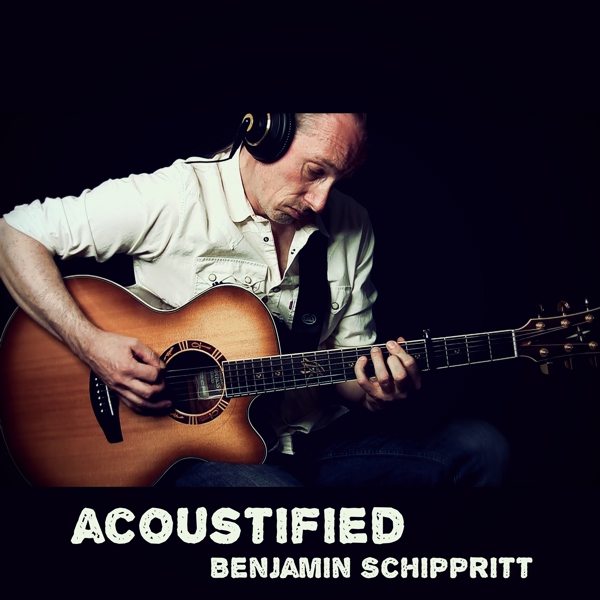News in 2025

July 1st 2025
You can find a brand new tutorial on my Youtube channel! I've already covered the topic of MODES in many videos, but this time I've taken another detailed look at it from a different perspective:
Visualize & Learn All 7 Modes with this Logical Fretboard Strategy
[Guitar-Nerdery 163]

Whether you're a total beginner or a seasoned pro, this 26-minute deep dive shows you exactly how to visualize, learn and connect all seven guitar modes with one clear, logical fretboard strategy.
In this tutorial you'll discover what a mode really is and how each of the seven (Ionian, Dorian, Phrygian, Lydian, Mixolydian, Aeolian, Locrian) derives from the major (Ionian) scale. You'll learn to build standard three-note-per-string scale shapes from the low E string, then compress each into three-string mode patterns on the E-A-D and A-D-G string sets. You'll see why using two positions per string group gives you instant orientation everywhere on the neck. Finally, you'll get a step-by-step method to link every shape into one seamless logical system.
June 26th 2025
Just a quick heads-up! Over the past couple of months, a whole bunch of fresh FULL and SHORTS guitar tutorials have gone live on my YouTube channel. If you haven't checked in for a while, now's a great time to dive back in-there’s plenty of new content waiting for you!
Elevate Your Rhythm: Pro Guitar Secrets to Master Odd Meters with Ease
[Guitar-Nerdery]

3-Octave Minor Pentatonic Scale Extension: Copy-Paste Diagonal Trick
[Guitar-Nerdery 071 ENHANCED]

Ear-Catching Guitar Licks: Octave Repeats / Copy-Paste Trick
[Guitar-Nerdery 072 ENHANCED]

Chromatic Guitar Playing Explained: Ignite Creativity, Craft Killer Licks
[Guitar-Nerdery 073-074 ENHANCED]

Inside/Outside Guitar Playing: Ignite Excitement, Craft Killer Solos
[Guitar-Nerdery 075 ENHANCED]

Fretboard Logic: 6-Pack Patterns for Clear and Organized Fretboard Navigation
[Guitar-Nerdery 123 ENHANCED]

The Rhythm Pyramid: A Practical Drill for Guitar Timing
[Guitar-Nerdery 017 ENHANCED]

Empower Fretboard Freedom and Speed with 3-Notes-Per-tut071String Scale Patterns
[Guitar-Nerdery 076 ENHANCED]

April 15th 2025
Hello guitar friends,
here we go! On my Youtube channel you will find more great, much improved tutorials from my Guitar Nerdery series:
Tapping Harmonics: Create Sparkling Melodies and Ethereal Chords
[Guitar-Nerdery 028 ENHANCED]

Master Quarter Triplets: The Proven Method to Upgrade Your Rhythm Skills
[Guitar-Nerdery 018 ENHANCED]

Discover the Irish Triplet Strumming Groove: A Rhythm Packed with Style
[Guitar-Nerdery 019 ENHANCED]

Refresh Your Blues Solos: Discover the Half-Whole Diminished Scale Power
[Guitar-Nerdery 099 ENHANCED]

Hirajoshi Scale Guitar Magic: Play All 7 Modes with this Exotic Scale
[Guitar-Nerdery Shorts Compilation]

March 11th 2025
Check out my YouTube channel with a bunch of new enhanced tutorials and exciting Lick-Compilations:
Fast Metal Guitar: Essential Picking Exercise for Speed & Precision
[Guitar-Nerdery 024 ENHANCED]

Metal Riff Alchemy: How to Craft Killer Minor Mode Variations
[Guitar-Nerdery 026 ENHANCED]

Metal Riff Alchemy: How to Craft Killer Major Mode Variations
[Guitar-Nerdery 027 ENHANCED]

Blues Rock Made Easy: How to Craft Killer Riffs with the Blues Scale
[Guitar-Nerdery 025 ENHANCED]

Hot Guitar Licks Compilation: 4 Thrilling Shreds
[Guitar-Nerdery]

Pro-Level Tapping Guitar Compilation Pt.1: 5 Amazing and Advanced Licks
[Guitar-Nerdery]

Pro-Level Tapping Guitar Compilation Pt.2: 5 Amazing and Advanced Licks
[Guitar-Nerdery]

February 9th 2025
Inverted Power Chords: Fat, Dark Sound WITHOUT Down-Tuning!
[Guitar-Nerdery 023 ENHANCED]

Hello dear guitar friends,
With the Al Di Meola Strumming Etude as the final episode, all 7 Guitar-Nerdery video tutorials about the Al Di Meola strumming technique are now available in optimized form on my Youtube channel!
I have also recently remastered a video about an interesting topic, namely the amazing fact that inverted power chords sound deeper than the notes they are made of. So you can create a sound effect of a down-tuned guitar on a standard E tuning guitar. I use this a lot when teaching when students want to play a particular song and the original was played down tuned. Many current tunings are so low that it would be beyond the scope of the lesson to retune so drastically for a single song. Using inverted power chords instead is not a full substitute for proper down-tuning, but very often it works surprisingly well. Furthermore, using inverted power chords is of course a great sound enrichment for your own creative outputs anyway.
Etude to train Al Di Meola's Strumming Style: Make the Technique Yours!
[Guitar-Nerdery 044 ENHANCED]

Elevate Your Strumming Skills!: Learn an Amazing Rhythm (Al Di Meola-Style)
[Guitar-Nerdery 029 ENHANCED]

Funk Guitar Bliss: with Al Di Meola's Efficient Strumming Technique
[Guitar-Nerdery 098 ENHANCED]

January 26th 2025
Hello dear guitar friends, you can now find me also on Bluesky.Social:
Bluesky.Social
January 25th 2025
Al Di Meola's Ultra Fast Fills: Speed-Building Strumming Exercises Pt.1
[Guitar-Nerdery 042 ENHANCED]

Al Di Meola's Ultra Fast Fills: Speed-Building Strumming Exercises Pt.2
[Guitar-Nerdery 043 ENHANCED]

Al Di Meola's signature fast 32nd note fills are a hallmark of his rhythm guitar style. In this video, I'll guide you through a series of guitar strumming exercises designed to help you build speed and seamlessly switch between 16th and 32nd notes with precision. If you're serious about mastering Al Di Meola's unique playing style, this training is a must!
Al Di Meola is renowned for his lightning-fast picking and virtuosic solo runs. My journey with his music began over 35 years ago when I first heard the award-winning live album 'Friday Night in San Francisco', featuring Al Di Meola, John McLaughlin, and Paco de Lucia. I was instantly captivated by their incredible talent. Al Di Meola's distinctive rhythm guitar playing, reminiscent of flamenco grooves, stood out to me. Despite the challenges I faced while trying to replicate his grooves by ear, I eventually discovered his unique right-hand technique. By studying his performances on TV and practicing in front of a mirror, I was able to emulate his style successfully.
Dynamic Strumming Techniques to Improve Your Rhythm Guitar
[Guitar-Nerdery 041 ENHANCED]

Hey everyone! In this remastered video, I'm diving into dynamic strumming techniques that will enhance your rhythm guitar skills. While this isn't specifically about Al Di Meola's strumming technique, I do use it to demonstrate various exercises for dynamic strumming. I'll be focusing on alternate strumming and showing you how to add life and dynamics to your groove by splitting the chord into low and high frequencies.
January 14th 2025
The Incredible Al Di Meola Strumming Technique: Play Faster With Ease!
[Guitar-Nerdery 020 ENHANCED]

Hello guitar friends! I'm thrilled to present the enhanced version of my tutorial on Al Di Meola's incredible strumming technique (Guitar-Nerdery Episode 020). While Al is famed for his lightning-fast solo picking, his rhythm guitar work is just as jaw-dropping. In this session, I'll walk you through his right-hand strumming technique he uses to achieve those controlled, rapid tempos without losing any punch. Imagine a flamenco twist but with a pick. Let's dive in and level up your strumming game together!
January 09th 2025
Hello dear guitar friends,
First of all, I wish you a Happy New Year! I'm thrilled to continue sharing many planned tutorials with you. My big wish this year is to finally find time to compose and produce music again. While I truly enjoy teaching, my primary passion is being a guitarist and a composer. Unfortunately, I haven't had much opportunity to do this recently, but it's essential for my motivation in the long run.
I've made some plans for this year, even though YouTube's algorithm can be quite unforgiving and punishes breaks. This year will be a journey to find the right balance. If you want to support me, simply watching my videos would be awesome. Liking and subscribing would be even more helpful and crucial for the long-term existence of my channel. A huge thank you to all of you who support my channel! Without you, none of this would be possible.
At the end of last year, and to ring in this year, I posted 4 compilations of my Guitar Advent Calendar 2024. Each compilation includes 6 cool and spot-on licks and tips from my repertoire. Please take a look; there's bound to be something interesting for everyone.
See you soon, Benjamin
6 Amazing Rock Guitar Licks & Tricks: Shred & More (1 of 4)

6 Amazing Rock Guitar Licks & Tricks: Shred & More (2 of 4)

6 Amazing Rock Guitar Licks & Tricks: Shred & More (3 of 4)

6 Amazing Rock Guitar Licks & Tricks: Shred & More (4 of 4)

News in 2024
December 21st 2024Hello dear friends,
Please forgive me for being a bit behind with the regular and timely updates on this website. Since the last in-depth tutorial, I've been working hard on a lot of video material. As you know, I do everything by myself, and lately, I've been feeling the limits of my energy.
I want to update you on some recently completed projects. On my YouTube channel, you'll find the tutorials Guitar-Nerdery 021 and 022, covering two of my favorite guitar tunings, Drop D and Drop B, combined and remastered into one video. Additionally, there's a huge two-and-a-half-hour anthology on all modes, which is probably one of the most comprehensive guitar tutorials on modes available on YouTube. I'm also currently posting my fourth Guitar Advent Calendar, with 24 daily, short, and precise tutorials. There are still a few days left until Christmas Eve, but if you've missed anything so far, you can always catch up on my YouTube channel. I hope you enjoy and learn a lot from these videos. Please don't forget to subscribe to and like my YouTube channel if you enjoy the content. If you have any suggestions or questions, feel free to leave them in the comment box. Your input might inspire future videos. If there are enough questions, I'll gladly do a Q&A session.
Cheers, Benjamin
Amazing Tunings: Drop D & Drop B (Easy Approach & Best Tuning Methods)
[Guitar-Nerdery 21/22

Master Every Guitar Mode: The Most Comprehensive Anthology for Serious Players
[Guitar-Nerdery

October 29th 2024
Ultimate Guide to The Minor Pentatonic: Shapes, Usage & Tips (Pros & Cons)
[Guitar-Nerdery 162]

Pentatonic Scale Mastery: 1 Scale Shape to Rule Them All! Unlock endless possibilities with the Minor Pentatonic Scale - transform it into the Major Pentatonic, Blues Scale, and more. Master multiple scale shapes for incredible versatility and musical freedom!
All pentatonic scale shape diagrams used in the video are available at the end for easy screenshots!
Welcome to my brand-new and hugest guitar tutorial ever! In this video, I dive deep into the pentatonic scale, specifically the minor pentatonic scale and its guitar scale shapes. I'll cover a bit of theory to open your eyes, applications, and practical tips and tricks for all levels. This scale is one of the most commonly used in Western music. The minor pentatonic scale is likely one of the first scales you'll encounter in guitar lesson books. Many guitarists, including myself, discover it intuitively because it's so logically structured and free of dissonant notes.
In this comprehensive guitar tutorial on the minor pentatonic scale, I won't just cover how to use it. The focus lies especially on the universal guitar scale shapes, and how only one of them is already sufficient to make use of numerous options. I'll show you various fingerings you can use to play this scale and also demonstrate how you can use these same fingerings to play the major pentatonic scale without having to learn new shapes.
I'll also show you how to easily expand these scales into the blues scale, which works in both major and minor. Additionally, I'll discuss the limitations of these scales. For example, you can use the minor pentatonic scale over all minor modes in the Ionian system because the specific notes of these modes are not included, so you can't hit a wrong note. The same applies to the major pentatonic scale. However, the downside is that you'll never get the specific sound of a particular mode if that’s what you’re aiming for.
But don’t worry, I'll also share some tricks on how to play certain modes with these minor pentatonic shapes and achieve the authentic mode sound. Again, without having to learn new fingerings!
Thanks for watching, and happy playing!
Best,
Benjamin
September 26th 2024
Hello dear friends!
Due to time constraints, I haven't been able to update this page in the past few weeks. However, I encourage you to visit my YouTube channel regularly, as I've posted many videos there, both long and short. This is also the reason for the lack of updates I just mentioned.
Below, you'll find all the links to my posts. In addition to numerous SHORTS videos, there are 10 vertical editions of my Junk Farm Guitar playthroughs. Most of my viewers watch my videos on their cell phones, so I thought it would be a nice addition for those who like to watch my playthroughs on the go.
I've also created three different compilations of all my guitar solos in my performance-related videos. Besides a compilation of all the guitar solos in my Junk Farm playthroughs, there're also a showcases of my solos from each of my solo projects and Guitar-Nerdery tutorials. Enough material for an entertaining evening with a tasty drink and some nibbles.
Have fun!
Benjamin Schippritt Guitar Solos:
Emotional and Melodic Improvisations Over Prog Rock/Metal Tracks

Benjamin Schippritt Guitar Solos:
Melodic Virtuoso Moments of My Solo Projects (Prog Rock Metal)

Benjamin Schippritt Guitar Solos:
Highlights from My Time with Junk Farm (Prog Rock Metal)

Benjamin Schippritt plays JUNK FARM! (Vertical Editions):
FULL Guitar Playthrough (Vertical Video):
MELODIC HARD ROCK 'Everything Wrong' by Junk Farm

FULL Guitar Playthrough (Vertical Video):
HI-PROGRESSIVE ROCK 'Damaged Brain' by Junk Farm

FULL Guitar Playthrough (Vertical Video):
GREEDCORE ROCK 'Little Greedy Girl' by Junk Farm

FULL Guitar Playthrough (Vertical Video):
'Still Not Dead' by Junk Farm

FULL Guitar Playthrough (Vertical Video):
KING'S X-ish STYLE POWER ROCK 'Eurovision Song-Incest' by Junk Farm

FULL Guitar Playthrough (Vertical Video):
OCTANE BLUES METAL 'Didn't Come to Dance' by Junk Farm

FULL Guitar Playthrough (Vertical Video):
PROGRESSIVE METAL 'An Eye For An Eye' by Junk Farm

FULL Guitar Playthrough (Vertical Video):
PROGRESSIVE METAL 'Lost by a Love Song' by Junk Farm

FULL Guitar Playthrough (Vertical Video):
Prog Rock and Funky Fusion 'Partymaniac' by Junk Farm

FULL Guitar Playthrough (Vertical Video):
Freaky Metal Fusion 'Perfect Dream' by Junk Farm

August 13th 2024
Boost Your Rhythm Skills: Pro Guitar Secret to Master Odd Meters with Ease
[Guitar-Nerdery 016 ENHANCED]

Learn about making Simple Subdivisions in Odd Time Signatures: An Easy Powerful Technique for All Guitar Players who want to Lift Up their Rhythm Skills!
Guitar-Nerdery 016 ENHANCED VERSION: This is a major upgrade and a completely revised re-release of my early 16th guitar tutorial!
I often get the impression that the subject of Odd Time Signatures triggers an intuitive fear in many musicians, a fear of being overwhelmed. In this video, I want to show you that learning to play in Odd Time Signatures is not a secret reserved only for over-talented musicians. Actually, the approach is ridiculously simple. Nobody counts to 13 in a 13/16 time signature - it just doesn't work that way. The trick is to divide an Odd Meter into smaller, countable units.
Check out the video where I demonstrate these subdivisions in numerous practical examples to give you an idea and inspire you with how cool a groove can sound in an Odd Time Signature!
July 19th 2024
Cross Rhythms: Essential Skills for Jaw-Dropping Prog Rock Guitar [Guitar-Nerdery 015 ENHANCED]

MAJOR UPGRADE! A Must-Learn, Skill-Building and Rewarding Prog Rock Guitar Experience!
Guitar-Nerdery 015 ENHANCED VERSION: This is a major upgrade and a completely revised re-release of my early 15th guitar tutorial. Improved image, audio and editing quality as well as additional on-screen features to greatly improve comprehensibility.
CROSS RHYTHMS (also known as polyrhythms) are not only fun, but also an essential skill to learn in order to play mind-blowing riffs and solos in the genre of progressive music. Progressive music is often associated with odd time signatures, and it is also the case that using odd time signatures automatically comes with the association of progressive music. A similar, equally cool effect can also be achieved in 4/4 time by using cross rhythms. Cross rhythms are small, usually odd rhythmic motifs that do not start on the 1 in the next bar when repeated. The last motif within a bar is a transit motif, so to speak, which crosses the bar line. Hence the name! It's great fun to play cross rhythms and allows you to make the position of the 1 unclear for a moment, which can lead to really exciting grooves!
July 09th 2024
Beat the Odds! How to Groove in Odd Meters [Guitar-Nerdery 014 ENHANCED]

Rhythm and Sole: Learn to Prog! A Guitarist’s Guide to Grooving in Odd Time Signatures!
Guitar-Nerdery 014 (ENHANCED VERSION)
This is a completely revised re-release of my early 14th guitar tutorial on this channel! (Enhanced Quality of Picture, Audio & Edits + Additional On-Screen Features)
Not only in my former video, I always advice to get used to practice with a metronome and tap along with your foot, making a part of your body connected and glued together with the beat! I guess everyone starts in 4/4 time signature, but the big question arises when it comes to Odd Time Signatures. How can you tap your foot here, what strategy makes sense? To put it bluntly, there is no such thing as THE solution, but in this video I'd like to give you a comprehensive demonstration of my strategy for getting the right groove feeling in different Odd Time Signatures.
July 03rd 2024
The Metronome: The Hidden Truth Behind Guitar Success [Guitar-Nerdery 013 ENHANCED]

No Metronome, No Mastery: The Non-Negotiable Tool for Guitar Progress
Guitar-Nerdery 013 (ENHANCED VERSION)
This is a completely revised re-release of my early 13th guitar tutorial on this channel!(Enhanced Quality of Picture, Audio, Edits and Additional On-Screen Metronome)
It's all about the rhythm! Whether you are a rhythm or solo guitarist, instrumentalist or singer - there is no difference in dealing with rhythm. The number of notes or chords doesn't matter at all if the rhythm isn't right. The metronome is the ideal partner right from the start to build up a secure and precise sense of timing. What can initially feel like an enemy quickly becomes a best friend for life!
Beat The Boring: Master Vital Strumming Grooves with Irish Triplets [Guitar-Nerdery 030 ENHANCED]

Elevate your rhythm skills: Learn an Irish Strumming Technique that opens doors to worlds of new, creative and fantastic grooves!
Guitar-Nerdery 030 (ENHANCED VERSION)
This is a completely revised re-release of my 30th guitar tutorial on this channel. While the guitar recordings were fine, something went wrong with the recording of my speaking at the time. I was able to improve the audio quality a bit, but more so the sound of the guitar, as well as the picture quality. Additional on-screen info and tighter scene editing will help you understand better.
In this video I first show you an important rhythm exercise, the 16th note off-beat training. This is followed by a series of rhythm exercises in which I adapt an Irish triplet strumming technique to 16th notes. By also making subdivisions of a 4/4 bar and therefore not playing with a constant alternate strumming technique, super interesting and inspiring grooves come to life. Difficult to explain, better watch it right away and be inspired!
June 09th 2024
EXCEPTIONAL ARPEGGIOS that Shine in the Spotlight
STRING SKIPPING [Guitar-Nerdery 004 ENHANCED]

Discover the Extraordinary Power of Shred with String Skipping Arpeggios
This is a completely revised re-release of one of my very first guitar tutorials on this channel. The recordings were made with the integrated camera microphone and the audio quality was accordingly poor. I have improved the audio quality as much as I could and also the picture quality. In addition, new graphics help you learn the arpeggio fingerings.
I'll show you some great arpeggios played with the string skipping technique. The hybrid picking technique is a good partner here. There are many ways to play arpeggios on the guitar and the fingering is crucial for what you can do with them. These string-skipping arpeggios make it possible to implement totally crazy rhythmic ideas and phrasing. I wish you lots of fun!
May 24th 2024
JAPANESE HIRAJOSHI SCALE: Incredible Versatile!
Play All 7 Modes [Guitar-Nerdery 107 ENHANCED]

One Scale (Shape) / Seven Marvelous Sounds! "The Hirajoshi Scale is the Most Versatile Pentatonic Scale I know! It's So Simple, Why Didn't I See This Sooner?"
Guitar-Nerdery 107 [Enhanced Version]
In Guitar-Nerdery Episode 106 I've shown you a nice sounding Japanese Pentatonic Scale, the Hirajoshi Scale. When I looked into it again, I had a spontaneous inspiration. I can't believe I didn't think of it straight away. If the Hirajoshi can be regarded as part of the Phrygian scale, then it is obvious that it can also be used to play the other six modes (Church Modes / Church Scales) of the Ionian System. I was curious to see whether the Hirajoshi Scale would also cover the important notes that the special sound of each mode requires. Yes, wow, even though two notes are missing, because it is a pentatonic, but in every mode this Japanese Scale cuts an amazingly fantastic figure. All modes work and even in a wonderful way, because the missing notes give all the others a special emphasis and you play the modes differently than usual. Totally cool!
In this improved video I show you, with the help of many scale diagrams, how you can use this wonderful Japanese Scale, the Hirajoshi Scale, to play all seven modes. The best thing is, it's totally easy. I only use one diagonal scale diagram to play everything. This scale pattern is also totally symmetrical, so it's easy to remember, and covers three octaves. A guitar with 24 frets has four octaves, so you can get really far with three octaves! Have fun!
May 12th 2024
ALL MODES BACKING TRACK (Key A Atmospheric Rock)
Sonic Remix in Logical Order

This ALL MODES BACKING TRACK is the Ultimate Practice and Experience Tool to understand the REAL SOUND (Difference) of Modal Scales, with your fingers and your ears! It is the same Backing Track I use for demonstration in my tutorial
Guitar-Nerdery 161.
MODE ORDER
1st Round: Lydian - Ionian - Mixolydian - Dorian - Aeolian - Phrygian - Locrian
2nd Round: Locrian - Phrygian - Aeolian - Dorian - Mixolydian - Ionian - Lydian
What it's about / description:
When you first learn about the modes (church modes), it's always about their origins, that all notes of the major scale (ionian scale) can act as independent fundamental notes, and that from their respective point of view, the semitone steps within the scale each take on a different position. This results in 7 differently structured scales, the modes, which also all sound different. To experience the real difference in sound, it makes sense to play all scales from the same root note (here Root A), and this is exactly what happens in this Backing Track. But that's not all, because I haven't arranged the modes in the same way as they are created, but according to intervals and therefore also according to sound!
The Backing Track begins with the mode that contains the largest intervals, the Lydian mode. The transition to the next modes is made by decreasing a single interval at a time until the seventh mode, Locrian, with the smallest intervals of all, is reached. Each mode is played for 16 bars, which should be enough to build up a feel for the sound and then experience how changing a single interval affects it. After the seventh Locrian mode, after counting in again, there is everything again, in reverse, from Locrian to Lydian.
The order of the modes is shown in real time on the display, including the notes contained in each mode. In addition, a Scale Pattern is displayed for each mode if you don't have your own to play along with the backing track, but also to visualize the metamorphosis through all modes for better understanding.
Enjoy and have fun!
Cheers, Benjamin
May 5th 2024
THE MODES REMIXED: An Eye-Opening SONIC REVELATION
(Use Scales as Colors) [Guitar-Nerdery 161]

Incl. FINAL EPIC GUITAR SOLO (which puts this New Approach to the test), because in the end it's the ear that decides how it sounds!
The Modes Reimagined - The Modes in a New Logical Order:
This video is a comprehensive guide that looks at the concept of the modes (on the guitar), their structure and how they relate to each other. I deal with the sonic world of the modes, which offer a wide range of sonic possibilities, a MUST KNOW for guitarists / musicians who want to develop their ability to play diverse and expressive solos, melodies and chord progressions.
The modal scales within a key are essentially created by using the same notes, but each with a different starting point. This respective starting point changes the arrangement of the whole and half steps within the scale, which is the reason for the different sounds of the modes. Using the notes of the Ionian scale (the major scale) as a reference scale, the following modes are created: Ionian, Dorian, Phrygian, Lydian, Mixolydian, Aeolian, Locrian. The development of this order is purely technical in nature, but has no relation to a logical order of sounds. And that's exactly what this Guitar-Nerdery episode 161 is all about! I start each individual mode from the same root note and thus deprive them of any reference to a common key. This makes the different sounds honest and obvious. Subsequently, I arrange the modes differently, logically according to the size of the musical intervals they contain.
My very personal experience is that the modes then also follow a logical sequence in terms of sound. The larger the intervals, the more open and brighter the sound. But as I said, this is my own personal perception! The finale of the tutorial consists of an extensive improvisation over a specially compiled backing track that runs through all the modes in the new order. I would be very interested to hear whether you perceive this in the same way as I do and would be delighted to receive your feedback!
I hope you enjoy my sound journey!
Benjamin
April 28th 2024
Mastering the LOCRIAN MODE / The Sound, Scale & Chords
(Frank Gambale Method) [Guitar-Nerdery 160]

April 21st 2024
Mastering the AEOLIAN MODE / The Sound, Scale & Chords
(Frank Gambale Method) [Guitar-Nerdery 159]

April 14th 2024
Mastering the MIXOLYDIAN MODE / The Sound, Scale & Chords
(Frank Gambale Method) [Guitar-Nerdery 158]

April 7th 2024
Mastering the LYDIAN MODE / The Sound, Scale & Chords
(Frank Gambale Method) [Guitar-Nerdery 157]

April 1st 2024
Mastering the PHRYGIAN MODE / The Sound, Scale & Chords
(Frank Gambale Method) [Guitar-Nerdery 156]

March 26th 2024
Mastering the IONIAN MODE / The Sound, Scale & Chords
(Frank Gambale Method) [Guitar-Nerdery]

Get the max out of the Ionian Scale / Mode with this Guitar Tutorial! The Ionian Scale is commonly refered as THE Major Scale. Learn how to play chord progressions, that perfectly reproduces, not just Major, but the true sound of the Ionian Mode. I call this concept the Frank Gambale Method. Frank Gambale, an incredible Jazz Fusion Guitarist released a VHS guitar tutorial way back in time, where he explained his concept, and this had a great impact on me and my understanding of the church modes. In this video I'll make a quick analysis of the scale, show you a scale shape to start with and in the main part, I'll share this awesome concept of Frank Gambale which makes use, in a clever way, of the Principle of Exclusion. 6 more videos about those other modes will follow weekly. The episode about the second mode Dorian is already up!
Watch also:
Mastering the Dorian MODE / The Sound, Scale & Chords
(Frank Gambale Method) [Guitar-Nerdery]

February 29th 2024
Benjamin Schippritt / Electric-Free Extravaganza
(Acoustic-Hard-Melodic Rock) [Official EP Stream]

February 28th 2024
Benjamin Schippritt / BEDHEAD
(Electric-Free Extravaganza / Official Audio)

February 27th 2024
Benjamin Schippritt / CHICKBAG
(Electric-Free Extravaganza / Official Audio)

February 26th 2024
Benjamin Schippritt / BILLY THE KID
(Electric-Free Extravaganza / Official Audio)

BILLY THE KID is (HARD) ROCK UNPLUGGED! This was a fun experiment of mine. About 20 years ago in 2005, during a vacation in Sweden, I wrote 3 songs with the idea of playing hard rock songs on acoustic guitar instead of electric guitar, unplugged style. As soon as I got back home, I produced the tunes completely on my own. I played the acoustic guitars with the heart and attitude of a rock electric guitarist. Apart from posting them on Soundcloud, I didn't do much else with them. Later, the song CHICKBAG found its way onto the third Junk Farm album DIDN'T COME TO DANCE in a slightly different way. Much later I had the idea to remix the songs and now, again much later, I suddenly realized that the songs are damn fun to listen to and I don't want to keep that from you! I again did a complete new remaster. Enjoy my song BILLY THE KID with the freshness of today!
February 19th 2024
Dominant 7 Chords / Game-Changing Techniques Every Guitarist Should Know
(Guitar-Nerdery 153)

Chord Knowledge for Instant Use! Learn about and Master Primary Dominant 7 Chords, Secondary Dominant 7 Chords, and Tritone Substitutes. Improve your chord progressions by adding excitement, tension and direction. A Dive into 3 Essential Strategies of how to use Dominant 7 Chords!
January 26th 2024
Creative Tapping Technique / 15 Licks, Tricks & Exercises (Ultimate Shred)
(Guitar-Nerdery 152)

Welcome to my new Guitar Nerdery episode, packed full with tapping goodies and perfect for some awesome shredding! When I kicked off my guitar tutorial series many years ago, one of the early episodes was about the tapping technique. Back then I explained that I didn't actually use this playing technique that actively anymore, but that I had activated it for the video. Looking back, this tutorial was also inspiring for me, because it triggered the idea of delving deeper into it again. Now, many years later, this playing technique has once again become an integral part of my game and I wouldn't want to be without it. Accordingly, there are numerous tapping videos in the arsenal of my Guitar-Nerdery series. In this informative, but also entertaining video, I have put together 15 YouTube SHORTS videos with tapping licks, tricks and exercises that are firmly in my playing vocabulary and that I would like to share with you!
January 14th 2024
Master 24 Days of Guitar / A Compilation of Utterly Useful Licks Tips & Tricks
(Guitar-Nerdery 151)

Welcome and Happy New Year! A couple of days ago I started 2024 with a new Guitar-Nerdery episode 151:
'Master 24 Days of Guitar: A Compilation of Utterly Useful Licks, Tips & Tricks' is an all-in-one guitar lesson that offers a wealth of knowledge for guitar enthusiasts. This video is my SHORTS Advent Calendar 2023, 24 episodes on 24 days, coming together in one super tutorial compilation. The lessons are designed to be inspiring and cut-to-the-chase, making them perfect for guitarists who want to learn new licks, tips, and tricks in a short amount of time. The video covers a wide range of topics. Whether you're a beginner or an experienced player, this tutorial offers something for everyone. So, grab your guitar, tune in, and let's master 24 days of guitar!
















